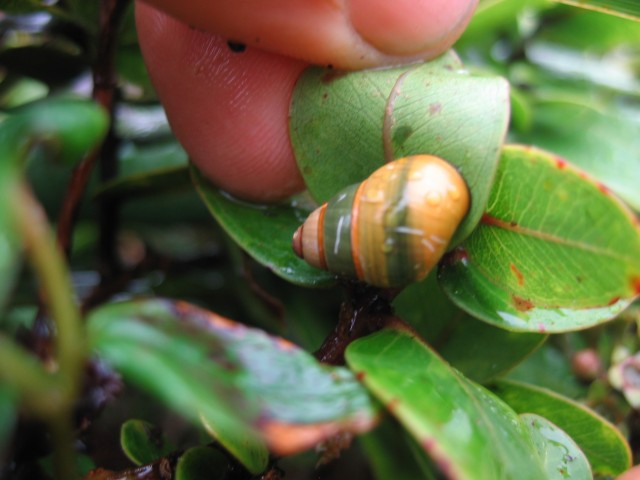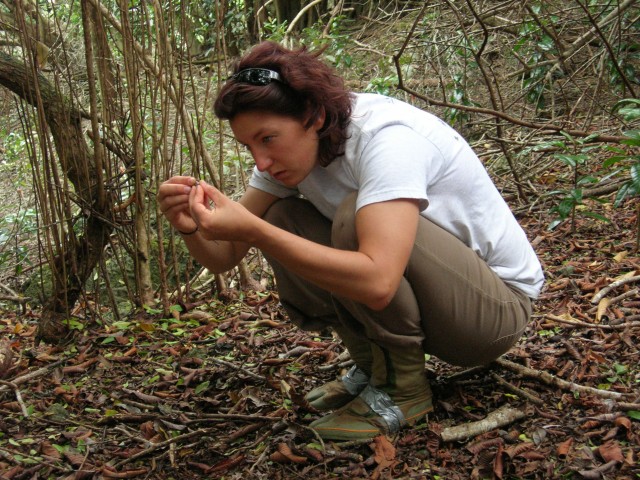<p>WAIANAE, Hawaii - The day started off with the loud "whoosh, whoosh, whoosh" of the rotors as the helicopter flew down to the landing zone, the powerful blades mesmerizing and menacing as they whipped weeds and debris into a frenzy - a testament to human invention.</p><p> Air transportation has come a long way, and for many of us, it's hard to imagine life without airplanes, regardless of baggage restrictions and ticket increases. However, humans weren't the first creatures to take advantage of air travel. </p><p>Scientists believe snails were early air passengers millions of years ago. By hitching rides on migrating birds, snails like the Achatinella, commonly called the Oahu tree snail, found their way to new destinations, according to Vince Costello, a rare snail conservation specialist with the Oahu Army Natural Resources Program (OANRP). </p><p>The Achatinella, like many Hawaii visitors, took a liking to island living, singling out predator-free Oahu in particular. The snails thrived here, evolving into a multitude of variations found nowhere else in the world. </p><p>They grew in size, moved from the ground into the trees, and seemingly took on the colors of the rainbow - their stripes varying in color from caramel and dark chocolate brown to midnight blue and vivid oranges and greens. The snails were so pretty that they were often referred to as "jewels of the forest," according to Costello. </p><p>Unfortunately, as human transportation expanded, the Achatinella suffered the consequences. Land clearing, the introduction of invasive (non-native) species and overcollecting have taken a toll on the snail. </p><p> "When the first European explorers came, they took shell lei back to Europe," Costello said. "These shell lei were really popular for a while, and people could make money selling them." </p><p>Historical accounts tell of people heading into the mountains on horseback and returning with bushels full of the thumbnail-sized snails. People amassed huge collections of these little "jewels," some upwards of 100,000 shells, Costello added. </p><p>Once widespread across Oahu, the Achatinella is now found only in pockets of the Waianae and Koolau mountain ranges. The snail was listed as an endangered species in 1981, but by then scientists believed more than half of the 41 species of Achatinella were already extinct; others haven't been seen in more than 25 years, Costello said. </p><p>A vibrant thread in the landscape and local culture (many generations have passed on the lore of the "singing" tree snail), the Achatinella is getting some aid from a number of agencies, and the Army is helping lead the charge. </p><p>The Army, as a federal agency, is required to protect threatened and endangered species found on its installations. The "serving and defending" may seem a little unusual, but the concept remains the same - protecting those who need protection. </p><p>Along those lines, the OANRP staff has been taking a holistic approach to protecting the Achatinella, addressing predators, ecosystem changes, invasive species and snail reproduction at the same time. For such a little guy, the Achatinella faces some larger-than-life threats. </p><p><b>"Land of ten thousand snails" </b>
Recently one Tuesday morning, members of OANRP's "orange" team boarded a four-man helicopter headed for Puu Hapapa, a snail site in the Waianae Mountain Range. </p><p>"This area was once known as the land of ten thousand snails," said Daniel Forman, OANRP field technician. Forman estimates the numbers are now closer to 500 or 600, there. </p><p>Armed with the tools of the trade - maps, peanut butter, bait blocks and spiked hiking shoes - the group set off to monitor, check, restock and record the condition of rat traps and poison bait stations in the known snail territory. Rats are one of the introduced species that prey on the Achatinella when hunger calls. </p><p> "We're on the brink of a lot of species going under, so that's why our efforts are so important," Forman said. "Our small staff can do a lot of good." </p><p>Almost on cue, the staff's efforts paid off finding a Euglandina rosea, commonly known as the Rosy wolf snail. Just as a wolf tracks its prey by scent, the Euglandina tracks its prey by taste, following the other snails' mucus trails. The cannibal Euglandina is roughly five times the size of the Achatinella and has a preference for small snails, which the Euglandina can eat whole. </p><p> "One Rosy wolf snail could kill a tree's entire population," Forman said. </p><p>A native of Florida, the Euglandina was brought to Hawaii to eat the non-native African snail, which is commonly seen in backyards and gardens across the island. Officials thought the pair-up would be a good solution because both snails were exclusively ground snails. As it turned out, the Euglandina didn't mind having to climb for dinner, sometimes being spotted 30 feet up in the trees. </p><p> "If Achatinella were seeing decline (in numbers) in the late 1800s (from land clearing), they hadn't even run into this guy yet," Costello said. "When Euglandina came in ... in a lot of places, they probably finished the Achatinella off." </p><p>After securing the troublesome Euglandina, the crew moved on to attack another snail threat: invasive plants. The crew "spread the snail love" applying weed killer to the invasive plants. During previous trips, the crew planted native plants in place of the invasive plants. </p><p>The Achatinella and native plants have evolved together over time, and it's not very common to see the snails taking a fancy to the invasive plants. What's more, invasive plants can change moisture levels in surrounding areas, and the snails need a wet climate to survive. </p><p>External threats aside, sometimes the Achatinella's own reproductive system seems like a traitor. </p><p> "They don't have many babies to start with, between one and four live young a year," Costello said. </p><p>Of course, that's after the four to five years it takes the snails to reach reproductive maturity. In contrast, some snails, like the African snail, mature within a matter of months and can lay several hundred eggs at a time. </p><p>Blow after blow, the prospects for this vivid snail seem dim, but a small light is at the end of the tunnel, or to be more precise, in the fridge. Aside from field efforts, OANRP staff have partnered with researchers at the University of Hawaii, providing the university with snails to breed and raise in captivity. </p><p> "One of the long-range plans for our project is to develop enclosures ... places free of rats and Euglandina ... and bring the snails from the lab back out," Costello said. "We want to ensure that they don't go extinct." </p><p>Until then, roughly 1,400 snails and counting, will bide their time in refrigerated containers, waiting for the chance to stretch their "feet" and slide.</p><p><b>Did you know...</b>
Aca,!Ac Before humans came to Hawaii, one snail species became extinct every million years. After Westerners arrived, an average of three snail species have become extinct each year.
Aca,!Ac Snails go into hibernation. Actually itAca,!a,,cs called estivation. During the summer months or periods of drought, snails can secrete a substance that serves as a glue between them and the leaf theyAca,!a,,cre on. This seal locks moisture in so the snails can survive.
Aca,!Ac Snails are right-handed and left-hand, just like humans. You can tell by looking at which way their shell spirals.
Aca,!Ac The Achatinella gives birth to live young Aca,!" shell and all! The shell continues to grow with the snail as it matures.</P>






Social Sharing